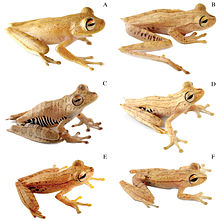화성 트로이 목마
Mars trojan화성 트로이 목마는 태양 주위의 화성 궤도를 공유하는 트로이 목성의 집단이다.그들은 화성의 60도 앞과 뒤 두 개의 라그랑지안 지점 주변에서 발견될 수 있습니다.화성 트로이 목마의 기원은 잘 알려져 있지 않다.한 이론은 그것들이 태양계가 형성될 때 라그랑지안 지점에서 포착된 화성 형성의 흔적이 남아 있는 원시 물체였다는 것을 암시한다.그러나 화성 트로이 목마에 대한 스펙트럼 연구는 그렇지 않을 [1][2]수도 있다는 것을 보여준다.또 다른 설명은 소행성이 태양계 생성 후반기에 화성 라그랑지안 지점으로 무질서하게 돌아다닌다는 것이다.이러한 [3][4]물체의 짧은 동적 수명을 고려할 때 이는 또한 의문입니다.유레카와 다른 두 개의 화성 트로이 목성의 스펙트럼은 감람이 풍부한 [5]조성을 나타낸다.감람이 풍부한 물체는 소행성대에서 드물기 때문에 화성 트로이 목성이 행성 [6][3]배아를 만났을 때 화성에 큰 궤도 변경 충격으로 인해 포착된 잔해일 수 있다는 주장이 제기되어 왔다.
현재 이 그룹에는 장기 수치 시뮬레이션을 통해 안정적인 화성 트로이 목마로 확인된 14개의 소행성이 포함되어 있지만, 이 중 9개만 소행성 센터에 의해 받아들여지고 있다.[7][3][4][8][9][10][11]
가까운 궤도 유사성으로 인해, L 그룹의5 작은 구성원들은 대부분 YORP 효과에 의해 회전된 후 분리된 유레카의 조각들로 가정된다(유레카의 회전 주기는 2.69시간이다).L 트로이 목마 19997 UJ의 회전4 주기는 약 50시간으로 훨씬 더 길며, 이는 YORP [12]스핀업을 방해하는 혼란스러운 회전 때문인 것으로 보입니다.
L4(선행):
L5(트레일링):
- 5261 Eureka (1990 MB) »
- (101429) 1998 VF31 †
- (3199) 2007 NS2 »
- (385250) 2001 DH47
- 2009년 SE
- 2011년 SC191
- 2011년 SL25
- 2011 SP189
- 2011년 UB256
- 2011년 UN63
- 2016 CP31
- 2018년 EC4
- FC4 2018
「 」를 참조해 주세요.
- 트로이 목마(천체)
- 트로이 목마 지점 근처를 도는 소행성
레퍼런스
- ^ Rivkin, Andrew; Trilling, David; Thomas, Cristina; DeMeo, Fancesca; Spahr, Timoth; Binzel, Richard (2007). "Composition of the L5 Mars Trojans: Neighbors, not siblings". Icarus. 192 (2): 434–441. arXiv:0709.1925. Bibcode:2007Icar..192..434R. doi:10.1016/j.icarus.2007.06.026.
- ^ Trilling, David; Rivking, Andrew; Stansberry, John; Spahr, Timothy; Crudo, Richard; Davies, John (2007). "Albedos and diameters of three Mars Trojan asteroids". Icarus. 192 (2): 442–447. arXiv:0709.1921. Bibcode:2007Icar..192..442T. doi:10.1016/j.icarus.2007.08.002.
- ^ a b c Scholl, H.; Marzari, F.; Tricarico, P. (2005). "Dynamics of Mars Trojans". Icarus. 175 (2): 397–408. Bibcode:2005Icar..175..397S. doi:10.1016/j.icarus.2005.01.018.
- ^ a b Schwarz, R.; Dvorak, R. (2012). "Trojan capture by terrestrial planets". Celestial Mechanics and Dynamical Astronomy. 113 (1): 23–34. arXiv:1611.07413. Bibcode:2012CeMDA.113...23S. doi:10.1007/s10569-012-9404-4.
- ^ Borisov, G.; Christou, A.; Bagnulo, S.; Cellino, A.; Kwiatkowski, T.; Dell'Oro, A. (2017). "he olivine-dominated composition of the Eureka family of Mars Trojan asteroids". Monthly Notices of the Royal Astronomical Society. 466 (1): 489–495. arXiv:1701.07725. Bibcode:2017MNRAS.466..489B. doi:10.1093/mnras/stw3075.
- ^ Polishook, D.; Jacobson, S. A.; Morbidelli, A.; Aharonson, O. (2017). "A Martian origin for the Mars Trojan asteroids". Nature Astronomy. 1: 0179. arXiv:1710.00024. Bibcode:2017NatAs...1E.179P. doi:10.1038/s41550-017-0179.
- ^ "List Of Martian Trojans". Minor Planet Center. Retrieved 2021-01-12.
- ^ de la Fuente Marcos, Carlos; de la Fuente Marcos, Raúl (April 2013). "Three new stable L5 Mars Trojans". Monthly Notices of the Royal Astronomical Society: Letters. 432 (1): L31–L35. arXiv:1303.0124. Bibcode:2013MNRAS.432L..31D. doi:10.1093/mnrasl/slt028.
- ^ Christou, A. A. (2013). "Orbital clustering of Martian Trojans: An asteroid family in the inner solar system?". Icarus. 224 (1): 144–153. arXiv:1303.0420. Bibcode:2013Icar..224..144C. doi:10.1016/j.icarus.2013.02.013.
- ^ Christou, Apostolos A.; Borisov, Galin; Dell'Oro, Aldo; Cellino, Alberto; Devogèle, Maxime (January 2021). "Composition and origin of L5 Trojan asteroids of Mars: Insights from spectroscopy". Icarus. 354 (1): 113994 (22 pages). arXiv:2010.10947. Bibcode:2021Icar..35413994C. doi:10.1016/j.icarus.2020.113994.
- ^ de la Fuente Marcos, Carlos; de la Fuente Marcos, Raúl (March 2021). "Using Mars co-orbitals to estimate the importance of rotation-induced YORP break-up events in Earth co-orbital space". Monthly Notices of the Royal Astronomical Society. 501 (4): 6007–6025. arXiv:2101.02563. Bibcode:2021MNRAS.501.6007D. doi:10.1093/mnras/stab062.
- ^ Lovett, R. (2017-10-20). "Sun's light touch explains asteroids flying in formation behind Mars". Science. doi:10.1126/science.aar2794.





